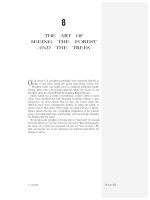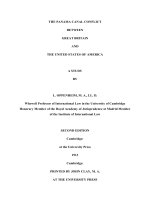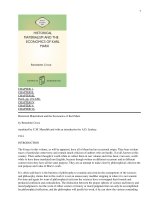invention of hysteria charcot and the photographic iconography of the salpetriere
Bạn đang xem bản rút gọn của tài liệu. Xem và tải ngay bản đầy đủ của tài liệu tại đây (11.24 MB, 386 trang )
Invention of Hysteria
This page intentionally left blank
Georges Didi-Huberman
Translated by Alisa Hartz
The MIT Press
Cambridge, Massachusetts
London, England
Invention of Hysteria
Charcot and the Photographic Iconography of the Salpêtrière
Originally published in 1982 by Éditions Macula, Paris. ©1982 Éditions Macula,
Paris.
This translation ©2003 Massachusetts Institute of Technology
All rights reserved. No part of this book may be reproduced in any form by any
electronic or mechanical means (including photocopying, recording, or infor-
mation storage and retrieval) without permission in writing from the publisher.
This book was set in Bembo by Graphic Composition, Inc.
Printed and bound in the United States of America.
Cet ouvrage, publié dans le cadre d’un programme d’aide à la publication, béné-
ficie du soutien du Ministère des Affaires étrangères et du Service Culturel de
l’Ambassade de France aux Etats-Unis.
This work, published as part of a program of aid for publication, received sup-
port from the French Ministry of Foreign Affairs and the Cultural Services of the
French Embassy in the United States.
Library of Congress Cataloging-in-Publication Data
Didi-Huberman, Georges.
[Invention de l’hysterie, English]
Invention of hysteria : Charcot and the photographic iconography of the
Salpêtrière / Georges Didi-Huberman ; translated by Alisa Hartz.
p. cm.
Includes bibliographical references and index.
ISBN 0-262-04215-0 (hc. : alk. paper)
1. Salpêtrière (Hospital). 2. Hysteria—History. 3. Mental illness—Pictorial
works. 4. Facial expression—History. I. Charcot, J. M. ( Jean Martin), 1825–
1893. II. Title.
RC532 .D5313 2003
616.85′24′009—dc21
2002029382
Acknowledgments vii
Principal Works Cited ix
Argument xi
I Spectacular Evidence 1
1 Outbreaks 3
2 Clinical Knowledge 13
3 Legends of Photography 29
4 A Thousand Forms, In None 67
II Charming Augustine 83
5 Auras 85
6 Attacks and Exposures 115
7 Repetitions, Rehearsals, Staging 175
8 Show-Stopper 259
Appendixes
1 The “Living Pathological Museum” 281
2 Charcot’s Clinical Lectures 281
3 Consultation 282
4 Preface to the Photographic Journal of the Hospitals of Paris 283
5 Preface to the Iconographie photographique de la Salpêtrière
(vol. I) 283
6 Preface to the Iconographie photographique de la Salpêtrière
(vol. II) 284
7 The Photographic Platform, Headrest, and Gallows 285
8 The “Observation” and the Photograph at the Salpêtrière 286
9 The “Photographic Card” at the Salpêtrière 287
10 Technique of Forensic Photography 287
v
Contents
11 The Portrait’s Veil, the Aura 289
12 The “Auracular” Self-Portrait 290
13 The Aura Hysterica (Augustine) 291
14 Explanation of the Synoptic Table of the Great Hysterical
Attack 291
15 The “Scintillating Scotoma” 292
16 Cure or Experimentation? 293
17 Gesture and Expression: Cerebral Automatism 293
18 A Tableau Vivant of Cataleptics 294
19 Provoked Deliria:Augustine’s Account 295
20 Theatrical Suggestion 297
21 Somnambular Writing 298
22 How Far Does Hypnotic Suggestion Go? 299
Notes 303
Bibliography 349
Index 369
vi
Contents
Pierre Bérenger, Jérôme Cantérot, Jacqueline Carroy-Thirard, Paul Cas-
taigne, Jean Clay, Hubert Damisch, Monique David-Ménard, Pianine
Desroche, Michel Foucault, Marie-Georges Gervasoni, Claude Imbert,
Brigitte Montet, Véronique Leroux-Hugon, Louis Marin, Jaqueline
Ozanne, Sylvia Pollock, Daniel Ponsard, Jacqueline Sonolet, Harrie Te-
unissen, and the Trésor de la langue française all had a part in this text, and I
am grateful to each of them, quite specifically.
G. D H.
The translator gratefully acknowledges the generous assistance of Tania
Roy, Enrico J. Cullen, Laura Chiesa, Dr. Arthur J. Hartz, Joshua Cody,
and, in particular, Juliette Leary Adams.
A. H.
Editions Macula would like to thank the Bibliothèque Charcot of the
Salpêtrière (Service of Professor Castaigne), as well as the Archivio storico
delle arti contemporanee of Venice for their courteous cooperation.
vii
Acknowledgments
This page intentionally left blank
IPS 1875 Iconographie photographique de la Salpêtrière. Bibliothèque Char-
cot, Salpêtrière Hospital.
IPS I Iconographie photographique de la Salpêtrière. By Bourneville and
Régnard. Paris: Bureaux du Progrès médical/Delahaye and Lecrosnier,
1876–1877. 167 pp. Figures: 40 plates.
IPS II Iconographie photographique de la Salpêtrière. By Bourneville and
Régnard. Paris: Bureaux du Progrès médical/Delahaye and Lecrosnier,
1878. 232 pp. Figures: 39 plates.
IPS III Iconographie photographique de la Salpêtrière. By Bourneville and
Régnard. Paris: Bureaux du Progrès médical/Delahaye and Lecrosnier,
1879–1880. 261 pp. Figures: 40 plates.
NIS Nouvelle Iconographie de la Salpêtrière. 1888–1918. Cited by article.
All references to the work of Sigmund Freud are to the Standard Edition of
the Complete Psychological Works of Sigmund Freud. Trans. and ed. James
Strachey. London: Hogarth Press, 1953–1974.
ix
Principal Works Cited
This page intentionally left blank
In the last few decades of the nineteenth century, the Salpêtrière was what
it had always been: a kind of feminine inferno, a citta dolorosa confining
four thousand incurable or mad women. It was a nightmare in the midst
of Paris’s Belle Epoque.
This is where Charcot rediscovered hysteria. I attempt to retrace
how he did so, amidst all the various clinical and experimental proce-
dures, through hypnosis and the spectacular presentations of patients hav-
ing hysterical attacks in the amphitheater where he held his famous
Tuesday Lectures. With Charcot we discover the capacity of the hysteri-
cal body, which is, in fact, prodigious. It is prodigious; it surpasses the
imagination, surpasses “all hopes,” as they say.
Whose imagination? Whose hopes? There’s the rub. What the hys-
terics of the Salpêtrière could exhibit with their bodies betokens an ex-
traordinary complicity between patients and doctors, a relationship of
desires, gazes, and knowledge. This relationship is interrogated here.
What still remains with us is the series of images of the Iconographie
photographique de la Salpêtrière. It contains everything:poses, attacks, cries,
“attitudes passionnelles,” “crucifixions,” “ecstasy,” and all the postures of
delirium. If everything seems to be in these images, it is because photog-
raphy was in the ideal position to crystallize the link between the fantasy
of hysteria and the fantasy of knowledge. A reciprocity of charm was in-
stituted between physicians, with their insatiable desire for images of Hys-
teria, and hysterics, who willingly participated and actually raised the
stakes through their increasingly theatricalized bodies. In this way, hyste-
ria in the clinic became the spectacle, the invention of hysteria. Indeed, hys-
teria was covertly identified with something like an art, close to theater
or painting.
But the constant escalation of these charms produced a paradoxical
situation: the more the hysteric delighted in reinventing and imaging
herself to a greater extent, the more a kind of ill was exacerbated. At a
xi
Argument
certain moment the charm was broken, and consent turned to hatred.
This turning point is interrogated here.
Freud was the disoriented witness of the immensity of hysteria in
camera and the manufacturing of images. His disorientation was not with-
out bearing on the beginnings of psychoanalysis.
xii
Argument
I
Spectacular Evidence
I am attempting, fundamentally, to reopen the question of what the word
“spectacle” might have meant in the expression “the spectacle of pain.” It
is an infernal question, I think, profoundly shrill and strident.
How might a relationship to pain already be projected, as it were, in
our approach to works and images? How does pain get to work, what might
be its form, what is the temporality of its emergence, or its return? How
does this occur before—and within—us and our gaze? This also raises the
question of which oblique paths true pain employs to give us mute access,
but access nonetheless, to the question of forms and signifiers.
In the end pain was the only name I could find for the event of hys-
teria, even in the very passage of its terrible attraction (and this is how the
question was first opened up).
I will interrogate this paradox of atrocity;at every moment of its his-
tory, hysteria was a pain that was compelled to be invented, as spectacle
and image. It went so far as to invent itself (for this compulsion was its
essence) when the talents of hysteria’s established fabricators fell into de-
cline. An invention is the event of signifiers. But what I want to speak of
is the meaning of the extreme visibility of this event of pain, the all too ev-
ident pain of hysteria.
Invention
Inventing can be understood in three different senses:
Imagining;imagining to the point of “creating,” as they say.—Then,
contriving [controuver], that is, exploiting in the imagination, overcreating;
in short, lying with ingenuity, if not genius. The Littré dictionary says that
controuver is incorrectly but nonetheless commonly used to mean contra-
dicting.—Finally, inventing is finding or falling right on the shock of the
thing, the “thing itself ”;invenire, coming to it, and perhaps unveiling it.
3
1
Outbreaks
Inventing is a kind of miracle (the miracle by which Christ’s Cross
was disinterred from the Temple of Venus surmounting the Holy Sepul-
cher, and then “recognized” by Saint Helena among two other crosses.
This miracle is celebrated as the liturgy of the so-called Invention and
Exaltation of the True Cross. What will be attempted here, between the
venereal body and crucifixions of pain, is precisely the opening of the
writings concerning the belated reinvention of a “Christian body.”) This
miracle is always infected, smoothly concealing the creation, imagination,
and abuse of images, the lies and contradictions—and, finally, the shock.
Infected, but from what? Nietzsche wrote:“Even in the midst of the
strangest experiences we still do the same: we make up the major part of
the experience and can scarcely be forced not to contemplate some event
as its ‘inventors.’ All this means: basically and from time immemorial we
are—accustomed to lying. Or to put it more virtuously and hypocritically,
in short, more pleasantly:one is much more of an artist than one knows.”
1
It is question four pages later of “counsels for behavior in relation to the
degree of dangerousness in which the individual lives with himself.”
2
I would like to interrogate this compromise and this threat, when,
in the context of hysteria, a physician finds it next to impossible not to ob-
serve, as an artist, the luxurious pain of a body in the throes of its symptoms.
Nor can I myself escape this paradox of atrocity, for I am nearly compelled
to consider hysteria, insofar as it was fabricated at the Salpêtrière in the
last third of the nineteenth century, as a chapter in the history of art.
The Outbreak of Madwomen
But there was indeed an extraordinary proliferation of images. Charcot
worked under the aegis of Fleury’s painting,
3
which exhibits, in the fore-
ground, the fetters and tools that tell the tale of the enchaining of the
madwomen and their “liberation” by Pinel (fig. 1);what is depicted is the
turning point, or rather the decisive chiasmus, which Pinel is said to have
effected in the mythology of madness.
4
This chiasmus was, in the first
place, the concept of madness that Hegel formulated, declaring himself
wholly indebted to Pinel;madness was not supposed to be an abstract loss
of reason, but a simple disorder, “a simple contradiction within reason.”
This means that, in principle, a madwoman should be supposed, or pre-
supposed, writes Hegel, to be quite simply a reasonable being.
5
This was
4
Chapter 1
Figure 1
Fleury, Pinel Liberating the Madwomen of the Salpêtrière (detail),
Bibliothèque Charcot, Salpêtrière.
indignation in the face of the misery of this unfortunate class of human-
ity, madwomen and madmen;Fleury’s canvas was painted to recount this,
too. And finally, Pinel’s Salpêtrière was opened as an asylum in the mod-
ern sense, whose first principle was the treatment of madness. A figure was
even put to the curability of insanity; a science was emerging, a thera-
peutic science:“. . . there is a kind of probability, 0.93, that the treatment
adopted at the Salpêtrière will be attended with success if the alienation is
recent and has not been treated elsewhere.”
6
But it was only a chiasmus: criss-crossed, but symmetrical.
Beautiful Souls
Pinel did indeed deliver the madwomen of the Salpêtrière; he released
them from total confinement, allowing them to coexist, notably through
work. This opening up, however, was also an insertion: Pinel invented
the asylum as a “little Government,” he said, with its own “interior Police
chief” and with “lodges,” “cells,” “dungeons,” and “padded cells.” And
when Esquirol arrived at the Salpêtrière in 1811, it was not as a doctor,
but still as a guard.
In short, the philanthropic “chiasmus” had the effect of tightening
other bonds, those of the asylum’s guilt, and thus isolating madness in an-
other way. Treatment became bound up with internment, for the felicitous
reason that one does not “submit” to an asylum’s organization, one simply
enters into it. One enters into it as one enters into the routine of daily life,
an infinitesimal and at the same time unlimited routine:the banal tender-
ness of the State. And the particularity of this chiasmus thus appears to us
as the permanence of a division made symmetrical: didn’t “psychiatric
consciousness” exist in an unhappy rift between the assurance of its im-
mediate knowledge and the failure of this knowledge in acts?
The failure consisted in the fact that madness can change form and
does do so, if you will, ninety-three percent of the time (see hysteria);
but madness was never scoured away, neither at the Salpêtrière nor any-
where else.
Now, a science that fails in its acts would have every reason to pro-
duce anxious scholars, as it were, especially if the object of the science is
madness, which, no matter what concept is sought for it, never ceases to
manifest itself as effects of speech, that is, something irrepressible. On the
other hand, it is said that the madman resembles us a little. Can a physi-
cian of madness refuse to see him as the dereliction of his own semblance?
Of course, this refusal takes place; it is existentially and epistemologically
6
Chapter 1
vital. “Psychiatric consciousness” could only refuse to be a shattered con-
sciousness, an unhappy consciousness at the very least. It held firm so as
to preserve its certainty as universality; it even preferred to refuse the act,
or to invent acts adequate to its certainty. With this risk of anxiety, it re-
fused to tarnish the splendor of its certainty and genius.
Then this consciousness could truly show itself to be an Artist,
but an artist in the sense of an aesthetic religion, in the sense of Hegel’s
beautiful soul.
Hypocrisy
This could also be called hypocrisy: hypocrisy offers a simple judgment as
an act or decree of reality, and is fully—if obscurely—aware that it is do-
ing so.
7
Hypocrisy is the equivocal displacement, Verstellung, of an inti-
mate consciousness of feigned truth, to the assumption of a feint of truth
before everyone—and the disdain for this very displacement. Hypocrisy
does of course characterize an ethical problem, but it must also be inter-
rogated along the following lines: how could a science, doubtless seeking
to ground its efficacy, find the constitutive principle of its methodologi-
cal demands in hypocrisy? I maintain that everything that happened at the
Salpêtrière, the great epic story of the clinic, is vested in hypocrisy, if the
complexity of the practices this word designates are admitted, and if this
complexity is not dismantled.
Hypocrisy is an act of choice, decision, and selection, of distinguish-
ing, separating, and resolving. It is an explanation. But it is only a little of
all these things, or perhaps it lies beneath them (hypo), secretly. The true
hypocrite (in Greek tradition, the hypokriter) is above all the one who
knows how to discriminate, but discreetly (in law, it is he who directs an
investigation). He is the one who knows how to give an interpreting re-
sponse, a soothsayer and a therapist; he can explain your dreams, humbly
lending his person to the voice of truth, and he can recite this truth, for
he is its rhapsodist. Which is also to say that he is the actor of truth.
Hypocrisy is a Greek art, the classical art of theater, a recitation of truth
through theatrical means, and thus fact [ fait], counterfeit [contrefait], and
feint [ feint] of the interpreting response.
“He was a hypocrite, an eye-twister, he twisted my eyes, he had
twisted [my] eyes . . . now [I see] the world with different eyes,” a woman
said of her beloved, a woman on the verge of madness.
8
For, as theater and an interpreting response, hypocrisy carries with
it the extraordinary epistemological gain of love. Pinel allowed the free and
public “license”of the madwomen,
9
and they in turn assumed an immense
7
Outbreaks
debt of love to him. Indeed, it was the conjugate effect of permission and
debt that allowed Pinel to glimpse the possibility of circumventing mad-
ness as a whole. This hypocrisy as stage direction is what I will interrogate
in Charcot:a strategic letting-be, a response that feigns to allow the word
of the other to spin out at its own rhythm, but a response that is always al-
ready interpretive, and thus oracular. It is hypocrisy as method, a ruse of
theatrical reason as it presumes to invent truth.
The Outbreak of Images
This failure should be rigorously judged. But the phenomenon is no less
dazzling nor even less effective—a dreadfully effective outbreak of images.
I must insist on the fact that Charcot was as if constrained to this
method, condemned to imagination and above all to what Kant called the
imaginatio plastica that represents [ figure] an intuition in space for the pur-
poses of transmission.
10
And this was Charcot’s great clinical and peda-
gogical promise, continually renewed: “In a moment I will give you a
first-hand experience, so to speak, of this pain; I will help you to recog-
nize all its characteristics”—how?—“by presenting you five patients”—
and he would have them enter the stage of his amphitheater.
11
(Perhaps he
was recalling Claude Bernard’s “scopic postulate”: “To understand how
men and animals live, it is indispensable to see a great number of them die”. . .).
12
Figuring and directing, but always at the limits of counterfeiting:this
is experimental fabrication (method) itself, a solid means of the modern
“conquest of the world as picture”—“die Zeit des Weltbildes.”
13
But this
method could not escape the figurative problem that obsessed every medical
clinic, the problem of the link—the phantasmatic link—between seeing
and knowing, seeing and suffering. How could all this passion be pro-
duced from figures of pain? This is the crucial phenomenological prob-
lem of approaching the body of the Other and of the intimacy of its pain.
It is the political problem of the spectacular interest paid by the observed in
return for the “hospitality” (the hospital’s capitalization) that he enjoys as
a patient. It is the problem of the violence of seeing in its scientific preten-
sions to experimentation on the body. That this experimentation on bod-
ies is performed so as to make some part of them—their essence—visible
is beyond doubt. Why then presuppose that Charcot was constrained to the
image, or to the imaginary?
Because the visible is a twisted modality.
And, first and foremost, the visible has its own particular manner of
interweaving that which is indelible in anxieties with their mastery. What’s
8
Chapter 1
more, Charcot was not alone in his practical debate with the visible; the
madwomen, too, had their own practices, no less sophisticated, of the in-
eluctable modality of the visible.
Crystal of Madness
The question is thus extraordinarily complex. It can never be reduced to
a smooth relation, free of angles, between seeing and being seen. How
should it be broached?
By dashing a crystal on the ground?
By way of an inquiry into psychic agency, Freud pictured the—how
shall I put it—crystalline, split, shattered relationship between madness
and the gaze:
Where [pathology] points to a breach or a rent, there may normally
be articulation present. If we throw a crystal to the floor, it breaks;
but not into haphazard pieces. It comes apart along its lines of cleav-
age into fragments whose boundaries, though they were invisible,
were predetermined by the crystal’s structure. Mental patients are
split and broken structures of this same kind. Even we cannot with-
hold from them reverential awe which peoples of the past felt for the
insane. They have turned away from external reality, but for that very
reason they know more about internal, psychical reality and can re-
veal a number of things to us that would otherwise be inaccessible to
us. We describe one group of these patients as suffering from delu-
sions of being observed. They complain to us that perpetually, and
down to their most intimate actions, they are being molested by the
observation of unknown powers—presumably persons—and that in
hallucinations they hear these persons reporting the outcome of
their observation: “now he’s going to say this, now he’s dressing to
go out” and so on. Observation of this sort is not yet the same thing
as persecution, but it is not far from it;it presupposes that people dis-
trust them, and they would be punished. How would it be if these
insane people were right. ?
14
I will leave his strange question suspended there: patience.
Morality of the Toy
To return to our subject, something was constructed at the Salpêtrière,
something resembling a great optical machine to decipher the invisible
lineaments of a crystal: the great, territorial, experimental, magical ma-
chine of hysteria. And in order to decipher the crystal, one had to break
9
Outbreaks
it, be fascinated by its fall, then break it again and invent machines per-
mitting an even more visible, regimented fall, and then break it once
again—just to see.
Thus nineteenth-century psychiatric knowledge must be interro-
gated well beyond its affirmations, designations, and discoveries. For this
knowledge is also like the prodigious diffraction of its own discourse into
often contradictory itineraries. It organizes itself around splits, incompat-
ibilities, and transgressions unknown to the beautiful soul. If the efficacy
of psychology is so poorly grounded, in all aspects of its method,
15
it is also
perhaps because it was often incapable of preventing itself from inflicting
on another the lethal gesture of a horrid, overcurious babe; psychology
can be pardoned for this, of course, for it wanted to know, just to know. This
passage, then, as an epigraph:
Most of the children want more than anything to see the soul, some
of them after a certain period of exertion, others right away. The
more or less rapid invasion of this desire determines the greater or
lesser longevity of the toy. I haven’t the heart to rebuke this child-
hood mania: it’s a first metaphysical tendency. When this desire has
penetrated the child’s brain marrow, it fills his fingers and nails with
a singular strength and agility. The child turns his toy over and over;
he scratches it, shakes it, knocks it against the wall, dashes it on the
ground. From time to time he puts it through the mechanical move-
ments yet again, sometimes in the opposite order. Marvelous life
comes to a halt. The child, like the people laying siege to the Tui-
leries, makes a supreme effort: finally he pries it partly open, for he
is the stronger. But where is the soul? Here begin stupor and sadness.
There are others who break the toy, barely examined, barely placed
in their hands. As for them, I admit that I am ignorant of the myste-
rious feeling that impels them to act. Are they seized by a supersti-
tious rage against these diminutive objects that imitate humanity, or
rather are they submitting them to a kind of Masonic rite before in-
troducing them into childhood life?—Puzzling question!
*
16
Might this be an introduction to the experimental method in psychology?
Disasters of Efficacy
One must retrace the experimental protocol of the great optical machine
of the Salpêtrière, while also summoning up a concern for its flaw, as in-
finitesimal as it may be—the sovereignty of the accidental:calling on dis-
aster itself as the horizon of its efficacy.
10
Chapter 1
*
[The final exclamation is in English in the original.—Trans.]
And what was the “drop of cruelty,” diffused throughout this will to
knowledge?
17
This blood of images?
Listen closely to these significant traumas: Salpêtrière, the great asy-
lum for women—a former gunpowder factory—the historic mistake of
1792 (a “conspiracy of women” supposed to be associated with a “con-
spiracy of prisons”)—and the “terrible massacre of women, of which His-
tory has provided no other example”
18
(fig. 2).
11
Outbreaks
Figure 2
The Terrible Massacre of Women at the Salpêtrière in 1792 (detail),
Musée Carnavalet.
This page intentionally left blank









